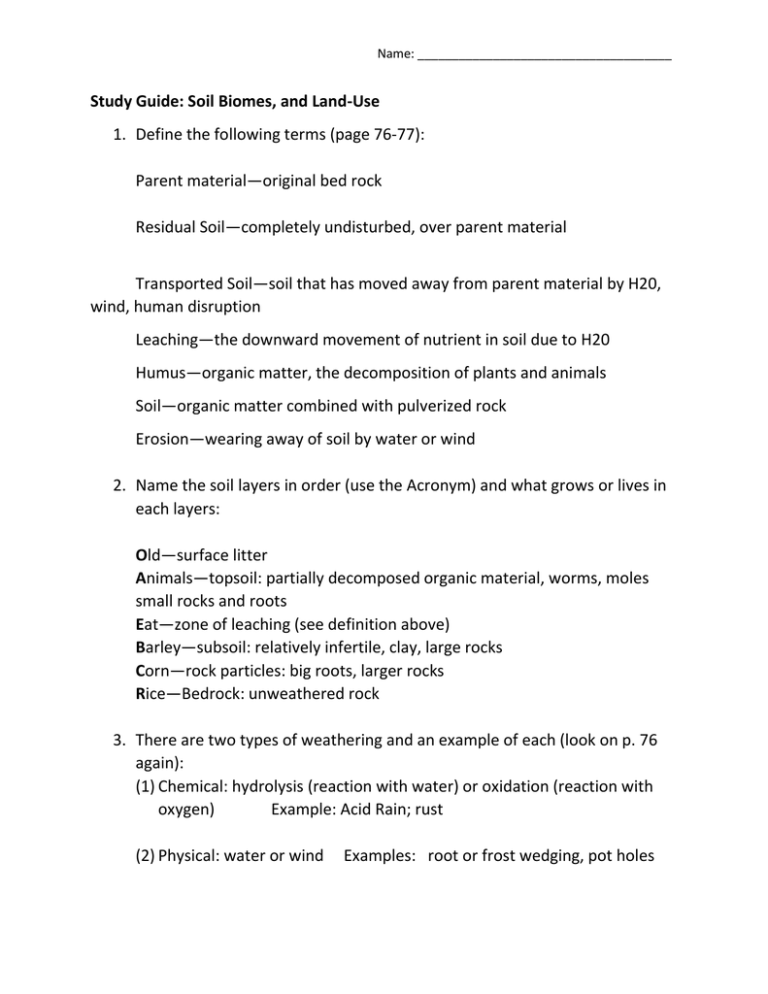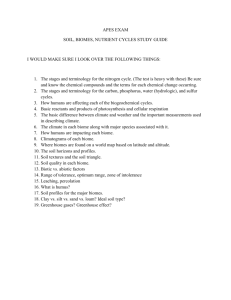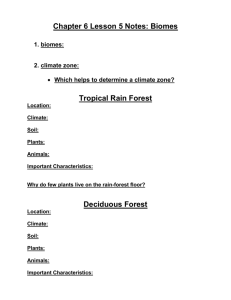Study Guide: Soil Biomes, and Land-Use Parent material—original bed rock
advertisement

Name: _____________________________________ Study Guide: Soil Biomes, and Land-Use 1. Define the following terms (page 76-77): Parent material—original bed rock Residual Soil—completely undisturbed, over parent material Transported Soil—soil that has moved away from parent material by H20, wind, human disruption Leaching—the downward movement of nutrient in soil due to H20 Humus—organic matter, the decomposition of plants and animals Soil—organic matter combined with pulverized rock Erosion—wearing away of soil by water or wind 2. Name the soil layers in order (use the Acronym) and what grows or lives in each layers: Old—surface litter Animals—topsoil: partially decomposed organic material, worms, moles small rocks and roots Eat—zone of leaching (see definition above) Barley—subsoil: relatively infertile, clay, large rocks Corn—rock particles: big roots, larger rocks Rice—Bedrock: unweathered rock 3. There are two types of weathering and an example of each (look on p. 76 again): (1) Chemical: hydrolysis (reaction with water) or oxidation (reaction with oxygen) Example: Acid Rain; rust (2) Physical: water or wind Examples: root or frost wedging, pot holes 4. On page 77, there are 5 soils types listed. Describe each one: (1) Tropical Soil-----found in a rainforest, hot, humid, moist Largest Soil profile: more than 10 feet (2) Grassland Soil---found in the Mid-West, grasses and grains, NOT trees Soil profile: 1 m or 3 feet (3) Forest Soil—Northeast and Mid-Atlantic (our region) hardwood trees (oak and maple) & softwood (pines) with seasons Soil profile: 1 m or 3 feet (4) Desert Soil—SW (TX, NV, UT, CO, AZ) hot dry Soil profile: mm (very thin) (5) Arctic Soil—AK always partially frozen Soil profile: cm 5. Define the following terms: Urbanization--at least 5,000 per square mile Salinization—soil that is not fertile because of its salt content Desertification—soil that becomes like a desert Overgrazing—too many animals eat/graze in an area for too long damaging the grass beyond repair or recovery. Arable—fertile soil, usable for agriculture 6. What percentage of Americans live in urban areas? 80% Tracy-Review—2015-6 2 7. What percentage of land in the U.S. is considered urban? 2% 8. (Look on p. 84) What is the purpose of the Public Rangelands Improvement Act of 1978? Manage range/grasslands to preserve the ecosystem. 1) eliminate weeds 2) fence out cows from sensitive areas (saving habitat) 3) create smaller watering holes. 9. What was the first U.S. National Park? Yellowstone 10.Draw a picture and label the different freshwater zones (look at page 106). 11.Draw a picture and label the different marine zones (look at page 107). Tracy-Review—2015-6 3 12.Know the bottom and top temperatures for each environment: Freshwater & Marine Freshwater: Bottom—39 degrees Top--- 72 degrees Marine: Top—72 and higher Bottom—37 degrees 13.The three animals you learned about in the internet activity on Biomes were: (1)Nutria Where is it from? Invasive South American rodent (2)Shrew Where is it from? Lives in the prairie, very aggressive live in any kind of habitat—related to moles. (3)Zorilla Where is it from? Skunk-like mammal from Africa savannahs. 15. What causes famine (page 110)? 1) drought 2) wars 3) poor governance 16. Describe the ‘green revolution’. (In your description, answer these questions: 1) is the green revolution sustainable? 2) Is the green revolution good for animals? 3) Is the green revolution good for the soil? 4) Is the green revolution good for water?) Green revolution revolved around the industrialization of farming. Larger machines, mono-cropping, the use of inorganic (synthetic) fertilizers, pesticides, herbicides, and increased irrigation all combine to create a culture of industrial farming—growing food. Small family farms are being run out because they can Tracy-Review—2015-6 4 not compete. No, the green revolution is not sustainable, and is currently showing decline leaving our world population in potential food insecurity. The soil, and water are generally harmed by overuse in this scenario. 17. Name 3 things that describe sustainable and unsustainable farming practices: Sustainable: (1) proper use of the land for growing and grazing. The right number of animals per acre, and crop rotation. (2) no pesticides or herbicides or inorganic fertilizer (3) organic fertilizer, being content with crop growth and ‘ugly’ fruit and produce. Unsustainable: (1) pesticides or herbicides or inorganic fertilizer (2) inefficient irrigation (3) use of heavy equipment (larger fields) and fuel for long distance transportation Biome Review Guide: Desert - The driest biome with less than 25 cm of precipitation annually and very little plant or animal life. Grassland - A biome composed of large communities of grasses and other small plants. It gets between 25-75 cm of precipitation annually. Taiga - This biome has forests of evergreens; pine, fir, hemlock and spruce. Soils are acidic and poor in minerals. It gets between 50 and 100 cm of precipitation annually. Tracy-Review—2015-6 5 Temperate Forest - This biome is composed of forests of broad-leaved hardwood trees that loose their leaves every year. It receives between 70-150 cm of precipitation annually. Tropical Forest - The tropical biome found nearest to the equator with warm temperatures and the most plant growth of any biome. It receives over 200 cm of rain annually. Tundra - The coldest land biome is found near Earth's north and south poles. It has no trees but has low, slow growing vegetation with permafrost below the topsoil. The tundra usually receives less than 25 cm of precipitation annually. Tundra in ‘Finnish’ (the language of Finland) means ‘barren land’. How would you describe the following biomes like a climograph? (use yearly temperature ranges, and precipitation) Biomes Temperate Grassland (Prairie) Rainforest Taiga Desert Savannah Temperate/Deciduous Forest Tundra Tracy-Review—2015-6 Temperature range (has seasons) 70 and 85° F -60 to 70 F 2-hot/wet No seasons 4 seasons 2 seasons Precipitation Between a forest & a desert Over 200 cm 50-100 cm Less than 25 cm 25-75 cm 70-150 cm Less than 25 cm 6



